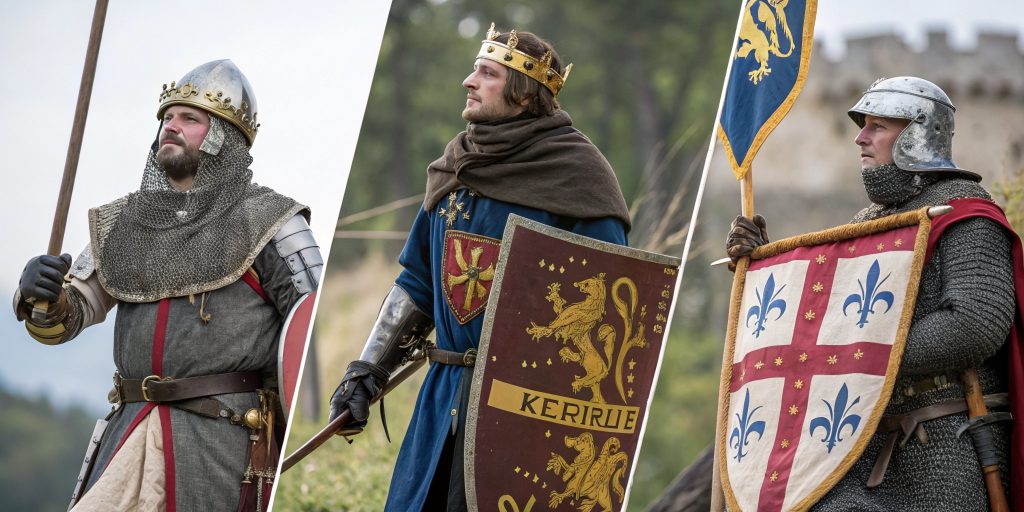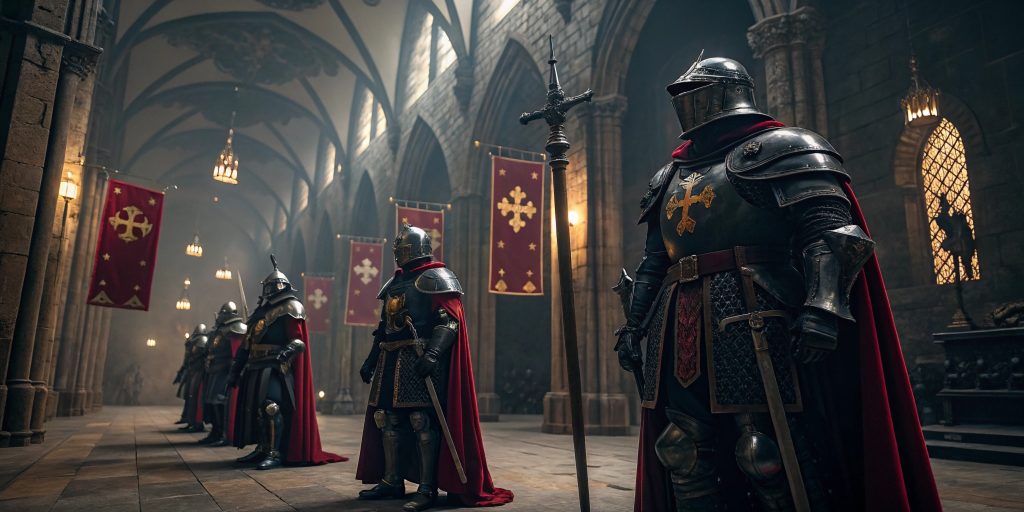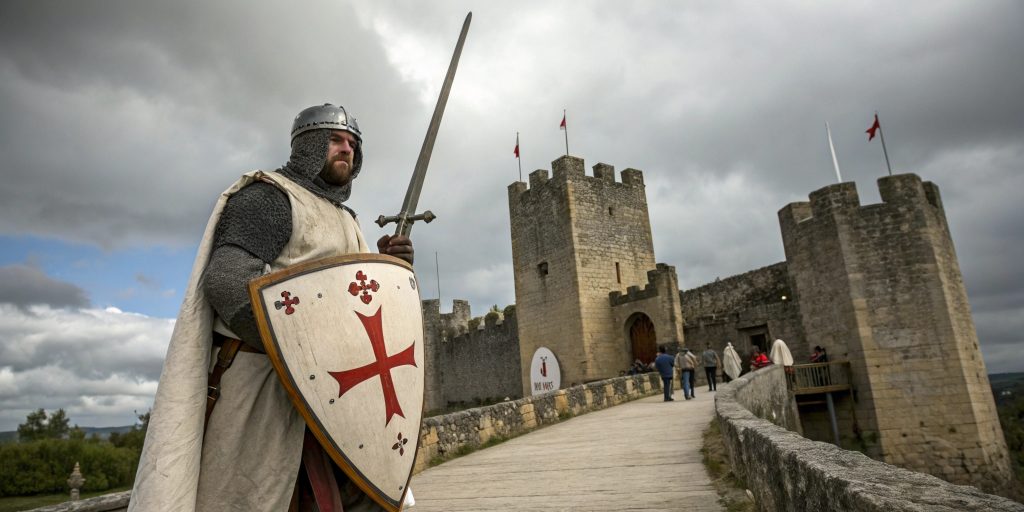In medieval Europe, knighthood was very important. It had many meanings, especially through titles for knights. These titles showed a knight’s status and gave them big responsibilities.
Becoming a Templar was a special goal. It meant following the ideals of chivalry and meeting the expectations of nobility. Knights had to go through a harrowing journey to prove their worth in the eyes of the order of chivalry. This journey was about showing their virtues and dedication.
The Evolution of Knighthood in Medieval Times
The history of knighthood in medieval times is genuinely captivating. It shows how society and values have changed over time. Knights first appeared in the early medieval period as mounted warriors. They were vital in defending territories.
Later, knights’ roles changed a lot. By the late medieval era, they had a clear hierarchy. This included different types of knights, each with their own duties and values. Chivalry became a key principle, focusing on honor, loyalty, and service.
Knights’ roles went beyond fighting. They played big parts in politics and local rules. Noble knightly orders emerged, showing knights as both warriors and leaders. This shows how knights adapted to a changing society and played a vital role in medieval times.
Understanding the Role of a Knight in Society
The role of a knight in medieval society was complex. Knights were warriors and protectors in the feudal system. They had to serve in the military, manage land, and enforce the law.
Knights did more than fight. They defended their lord’s land and kept the peace. This showed how important they were to society.
Knights were seen as symbols of honor, loyalty, and bravery. Their actions showed the worth of their lords and the nobility. Being virtuous helped knights earn respect and trust within their respective orders of chivalry.
Knights and peasants had a special relationship. Knights were leaders, mediators, and examples in their communities, helping to maintain the social order of medieval society.
Different Types of Knights and Their Titles
Knighthood in medieval times had many orders, each with its duties and titles. Knights like the Knights of the Holy Sepulchre, the Knights Templar, and the Knights Hospitaller were known for their bravery and faith.
Knights of the Holy Sepulchre
The Knights of the Holy Sepulchre protected Christian sites in Jerusalem. They were vital in the Crusades, guarding the Church of the Holy Sepulchre. They also helped pilgrims on their religious journeys.
Knights Templar: The Sacred Order
The Knights Templar started in the early 12th century. They were famous for guarding pilgrims to the Holy Land. Known for their discipline and bravery, they were also skilled in finance.
Knights Hospitaller: Care and Chivalry
The Knights Hospitaller helped sick and injured pilgrims. They displayed a balance of charity and war. Today, they are remembered for their kindness and courage.
The Hierarchy of Ranks Among Knights
The ranks of knights show their social status, duties, and power in medieval times. Each title meant more than just a name. It showed a knight’s loyalty and ties within the knightly orders.
For those new to knighthood, the knight bachelor is the starting position. It means serving a lord but not leading a group. As they gain experience, they might become a knight banneret, which shows they lead in battle.
The grand master is at the top, leading orders like the Knights Templar. They have power and must plan battles and charity work.
Knowing about knight ranks shows how chivalric orders worked. These changes affected politics in medieval Europe. They showed who was in charge and who was not.
Medieval Titles for Knights: Ranks and Distinctions
The medieval system of knight titles was complex, with many ranks and distinctions. Each title had its duties and rights and was placed in the knighthood orders. The knight bachelor, knight banneret, and grand master were vital in the growth of martial leadership.

The Title of Knight Bachelor
The knight bachelor was the first rank for new knights. It showed they were ready to serve and show bravery. They fought for lords or senior knights, building their fame.
Understanding Knight Banneret
The knight banneret was a higher rank, leading troops and carrying a banner. This rank showed leadership and importance in the war. It also showed the value of working together in battle.
Grand Master: The Highest Rank
The grand master was the top rank, leading orders like the Knights Templar. They were in charge of battles and keeping chivalry alive. This rank was the highest honor for a knight’s bravery and honor.
Chivalric Orders and Their Significance
Chivalric orders were key in medieval times. They shaped society and knightly behavior and made chivalry a big part of knights’ lives.
Being part of a noble order, like the Order of the Garter, was very important. It showed honor and helped in making alliances and gaining power. The rules of these orders guided knights, helping them stay true to their values.
- Bravery in battle and protecting the weak were key values.
- The honor was crucial for each order’s reputation.
- Loyalty to others was important, shaping friendships and alliances.
Chivalric orders showed how important chivalry was for knights. They helped create a shared identity. This identity defined their honor and roles in society.
The Code of Chivalry and Expectations of Knights
The code of chivalry was key for knights in medieval times. It set rules for their actions in peace and war. Honor and valor were at the heart of this code, defining a knight’s character.
Honor and Valor in Medieval Warfare
In war, knights were expected to do more than fight. They had to act with integrity and respect everyone. They needed to show courage, facing dangers head-on.
These qualities made them better warriors and earned them respect. Knights who lived by these values were admired by all, especially those of the order of chivalry.
Knights and Squires: The Training Process
Training to be a knight was tough, starting early. First, they were squires, learning combat and chivalry from seasoned knights. They got both physical and moral training.
Squires learned about honor and valor, essential qualities for any aspiring medieval knight. This prepared them for the duties of knights. The training showed the hard work needed to become a knight.
The Path to Becoming a Knight Templar
Becoming a Knight Templar is a challenging journey. It requires meeting strict requirements for knighthood. Candidates often came from noble families, bringing social status and resources.
But it’s not just about family. Intense religious devotion is key. Candidates went through religious ceremonies and education to prepare for their roles in the order of saints. This deepened their faith, making them more than just warriors.
They also received military training, which included learning how to fight, ride horses, and use weapons. This training was crucial for their role.
After training, candidates took the military vows. These vows were about living a simple life, being chaste, and obeying. These vows showed their true commitment to the order.
The initiation was a big step. It marked a lifelong promise to follow the Templar’s values. This mix of fighting skills and spiritual strength made Templars a special group.
Royal and Noble Orders of Knighthood

The bond between monarchs and knighthood goes back a long way. Royal orders of knighthood, such as the Order of Merit, were set up to honor service and loyalty. They also helped shape the social order of medieval times.
Orders like the Order of the Bath and the Order of St. Michael show how royal power and noble titles are linked to the ranks and titles of the nobility. They highlight the crown’s role in giving out titles.
Getting a title from the king meant more than just honor. It also meant a higher status in society. This helped knights and nobles who supported the king and inspired others to seek such honors.
These orders were key in medieval society. They created a web of loyalty and support for the king. Knights and nobles worked hard to uphold their titles, showing bravery and loyalty.
- The Order of the Bath: Established in 1725, this order is one of the most distinguished royal orders of knighthood, reflecting the legacy of knight commanders.
- The Order of St. Michael: Known for its exclusivity, it highlights the importance of loyalty and bravery.
- The importance of monarchical orders reinforced social structure and loyalty within medieval society.
Influence of the Monarchy on Knighthood
The monarchy powerfully shaped knighthood in medieval times. Kings used their power to create alliances and control. They gave out noble titles to keep knights loyal, reinforcing the importance of ranks and titles.
Kings made knights serve as vassals. This meant knights had to protect the king’s interests for land and status, as knight commanders often did. This system made the king’s power strong over his people.
Titles from the king meant loyalty and honor, and the nobility saw themselves as part of the royal family.
- Royal decrees greatly affected the creation and recognition of knightly orders.
- The rules of knighthood changed as kings made new laws.
- Knights were warriors and symbols of the king’s power and values.
So, knighthood became linked with royal bloodlines. This showed that being a knight was more than just an honor; it was a commitment to the order of knights. It was a sign of the king’s trust and power.
Medieval Military Orders: Structure and Function
Medieval military orders were vital in the Middle Ages. They included groups like the Knights Templar and the Knights Hospitaller, which had unique structures for fighting and helping others.
Leadership in these orders was clear. A Grand Master or Commander led the knights and soldiers. Knights, sergeants, and others worked together for battles and charity.
- Knights were seen as heroes, filled with duty and honor.
- Support teams were crucial for planning and managing resources.
- Leaders made big decisions, guiding actions in war and charity.
These orders did more than fight. They also ran hospitals for the sick and wounded, showing their wide range of work during important times.
Looking into how these orders worked shows their big impact. They defended their faith and helped society. This made them respected and powerful in the medieval world.
Conclusion
Looking back at medieval knighthood, we see how titles shaped society and military order. Knights were more than just fighters. They stood for honor, loyalty, and chivalry, values we still discuss today.
The Knights Templar and Knights Hospitaller set rules for knights, helping define their duties to society. This shows how vital knights were in their time.
The idea of chivalry still affects our views on justice and ethics. It teaches us about courage and helping others, virtues every medieval knight upholds. Learning about medieval titles helps us understand past societies and their values, particularly those related to the order of the golden fleece.
In short, knights’ titles and roles were vital in medieval times. They also guide us today. Let’s keep the spirit of chivalry alive for future generations.

